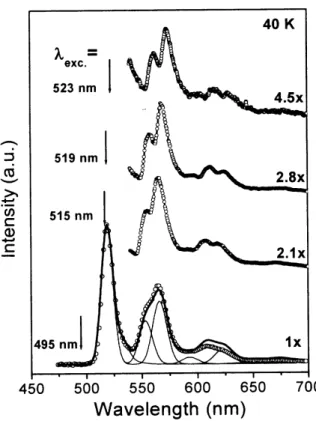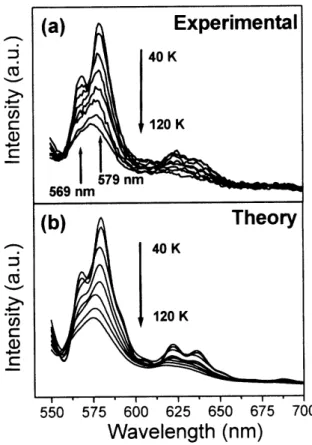590 Brazilian Journal of Physics, vol. 34, no. 2B, June, 2004
Vibrational Structure of Organic Semiconductors:
The Role of Conjugation Length
C. A. M. Borges, A. Marletta
†, R. M. Faria, and F. E. G. Guimar˜aes
Instituto de F´ısica de S˜ao Carlos, Universidade de S˜ao Paulo, CP 369, CEP 13560-970, S˜ao Carlos, SP, Brazil
†
Faculdade de F´ısica, Universidade Federal de Uberlˆandia, CP 593, CEP 38400-902, Uberlˆandia, MG, Brazil
Received on 31 March, 2003
Site-selective luminescence spectroscopy (SSL) was employed to resolve the vibracional modes in self-assembled poly(p-phenylene vinylene), PPV. Using Franck-Condon analysis, the PPV spectra can be well described by three effective vibrational modes at 330, 1160 and 1550 cm−1. As the temperature increases
from 4 to 180 K the electron-phonon coupling (S factor) remains constant for the 1550 cm−1mode while for other lower energy modes the coupling increases monotonically. This trend is consistent with the decrease of the conjugation length due to the increase of thermal disorder. We find that the temperature dependence of vibrational progression in PPV films is determined mainly by low frequency torsional modes.
1
Introduction
The coupling of the electronic properties to structural changes is of special importance in the case of conjugated polymers [1-3]. The parameter that makes optical properties to be very sensitive to conformational and thermal disorder is the Huang-Rhys factorS. The coupling constant S is re-lated to disorder through the degree of the chain conjugation. However, the exact relation between S-factor and conjuga-tion length is not well establish [3]. In the present work, we studied experimentally and theoretically the effects of ther-mal disorder on electron-phonon coupling in the emission spectra of the model polymer poly(p-phenylene vinylene), PPV.
2
Experimental procedure
The experiments were performed with high quality PPV films prepared by self-assembly (SA) methodology and con-verted at 110 oC for 30 min [5]. Site-selective
lumines-cence (SSL) was carried out using a very narrow excitation-line (spectral bandwidth of∼1 nm), which was obtained through the dispersion of the light of a 450 W Xe-lamp by a 1 m monochromator. Details of the PL set-up are given in Ref. [5].
3
Results and discussions
Figure 1 displays luminescence spectra (40 K) of a SA PPV film upon scanning the light excitation wavelength λexc
across the low energy tail of the absorption band that over-laps the luminescence spectrum. In the non-resonant case (λexc=495 nm) we observed the standard PPV spectra with
Figure 1. Dependence of SSL spectra onλexc(arrows). The bot-tom spectrum shows a full spectral line shape (circle) and its theo-retical fit through Frank-Condon analysis (line).
a narrow zero-phonon line at 521 nm followed by a vibronic progression consisting of least three overtones, which are the combination of different effective backbone stretching modes [3].Once λexc moves into resonance with the
C.A.M. Borgeset al. 591
conjugated segments are excited and line narrowing occurs. As a consequence, the dominant unresolved vibronic band around 576 nm splits into a doublet. Using Franck-Condon analysis [3] for the bottom spectrum of Fig.1, we notice that the vibronic progression can be well described (contin-uous curve) by the overlapping of three effective, inhomo-geneous broadened phonon modes with energies 330, 1160 and 1550 cm−1. The last two modes coincide with the split-ted structure observed in the resonant case and are assigned to stretching vibration of vinyl group and phenyl ring [3,4]. The feature around 330 cm−1 has been associated to low frequency out-of-plane torsional modes [4].
We used the well-resolved vibronic modes and Franck-Condon analysis to study the dependence of electron-phonon coupling on the thermal disorder. Fig. 2a shows the SSL spectra (λexc=523 nm) in the region of vibronic
pro-gressions for different temperatures varying from 40 to 120 K. In this temperature range there are no significant spec-tral shift and line broadening. This is of particular impor-tance in the next analysis since the only varying parame-ters used in the spectral fitting were the Huang-Rhys factors Si(i=1,2,3), i.e., the coupling constants for the modes with
energies 330, 1160 and 1550 cm−1, respectively. The de-crease of the spectral intensity is related to non-radiactive processes activated by temperature and it was not essential in the present analysis.
Figure 2. Temperature dependence of SSL spectra in the region of vibronic progression (a) and their theoretical fitting using Frank-Condon analysis (b).
Figure 2b shows the theoretical spectra obtained from a fit of those in Fig. 2a. The result thus calculated fits the
experimental data quite well. It has to be remarked that the strong changes in the spectral shape observed in such narrow temperature range can be mainly accounted for the change of the electron-phonon coupling given by theSi
fac-tors. The temperature dependence of eachSiobtained from
the fitting is displayed in Fig. 3. One observes that the cou-pling constant increases with temperature for the two less energetic modes (330 and 1160 cm−1). This trend is con-sistent with the fact thatSjis a decreasing function of
con-jugation lengthn. Since disorder decreasesn, one expects that the higher the thermal disorder of a system, the larger the S factor. Conversely, the higher energy mode (1160 cm−1)presented an almost constant behaviour in the tem-perature range. Both behaviour can be well explained by a n-dependent Sirelation of the form Si= Si0+ai/(n+1) [3],
Si0is the S-factor at T=0 K and ai is an adjustable
param-eter. The temperature dependence of the conjugation length is given by n=noexp(-ε/kT) [1], whereεis a characteristic
energy of the conformational process and nois the effective
conjugation length at t=0 K. The value no=7 was determined
from temperature dependence of the energy difference be-tween HOMO-LUMO states. From the data of Fig. 3 one find same value ofε(=39 meV) for all phonon modes, which is in the range of the torsional barrier for polyenes [2].
Figure 3. Temperature dependence of the Si(i=1,2,3) factor for the effective vibrational modes (300, 1160 and 1550 cm−1). The
continuous lines depict the expected theoretical behaviors for each Si.
4
Conclusion
In the present work we find that the Huang-Rhys factor of each mode increases differently with the temperature. We can regard as a result that the main changes of the lumi-nescence spectra with temperature is accounted mainly for the variation of the electron-phonon coupling of the low fre-quency torsional modes.
Acknowledgement
592 Brazilian Journal of Physics, vol. 34, no. 2B, June, 2004
References
[1] S. N. Yaliraki, R. J. Silbey, J. Chem. Phys. 104, 1245 (1996). [2] P. Wood , D. W. Samuel, R. Schrock, and R. L. Christensen,
J. Chem. Phys. 115, 10955 (2001).
[3] R. Chang, J. H. Hsu, W. S. Fann, K. K. Liang, C. H. Chang, M. Hayashi, J. Yu, S. H. Lin, E. C. Chang, K. R. Chuang, and S. A. Chen, Chem. Phys. Lett. 317, 142 (2000) and references there in.
[4] S. Heun, et al, J. Phys.: Condens. Matter. 5, 247 (1993).
[5] A. Marletta, F. A. Castro, D. Gonc¸alves, O. N. Oliveira Jr., R. M. Faria, and F. E. G. Guimar˜aes, Synth. Met. 121, 1447 (2001).

